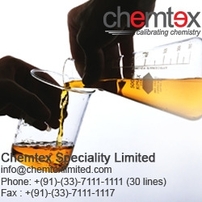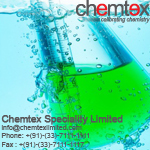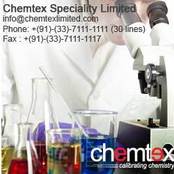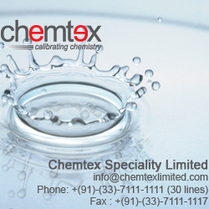 Orange Colored Inhibited Mono Ethylene Glycol General Name: Pre-Inhibited Ethylene Glycol based Heat Transfer Fluid - Orange Color Product Description: Orange colored Inhibited Ethylene Glycol is used as an industrial coolant, antifreeze heat transfer agent. The inhibitor package is designed to protect brass, copper, solder, steel, cast iron, aluminum and other metals commonly found in the industrial cooling and heating systems. The effectiveness of Inhibited Ethylene Glycol in preventing corrosion has been proven in extensive laboratory and in actual service tests. Using Inhibited Ethylene Glycol for heat transfer applications instead of brine solutions or uninhibited ethylene glycol reduces maintenance costs and improves heat transfer efficiency. Application Areas:- Beverages & Juices
- Breweries & Distilleries
- Thermal Storage System
- Pharmaceutical & Bulk Drugs
- Snow Melting & Refrigeration
- Oil Refineries
- Automobile Coolant Manufacturers
- Ice Skating Rinks
- Rubber Industry
- Cold Storage Systems
- Cold Rolling Mills
- Milk and Dairy Industry
- Meat Processing Industry
- Solvent Extraction Units
- Vanaspati & Vegitable Oils
- Industrial Coolants
Product Physio-Chemical Data:- Form and Appearance : Orange colored liquid
- Mono Ethylene Glycol : 97% ± 0.5%
- Inhibitor package and water : 3.5% ± 0.5%
- pH of solution : 10.0 ± 1.0
- Solubility in Water and Glycol : 100%
Orange Colored Inhibited Ethylene Glycol is used as heat transfer agent in food, beverage or brewery industries, there lays a possibility of contamination even though Ethylene Glycol is harmless to our health up to a certain level. But to keep ourselves on the safer side of the problem, something has to be done to detect the leakage of Glycol from the system. But we are fortunate enough that it had already done. Chemtex’s offered a perfect blend of Inhibited Ethylene Glycol and a colored leak detecting media. This media turns the Glycol solution to blue or orange or red colored solution. So, whenever there is any leakage from Glycol systems, it will be visible during the daylight and even in the night time due to its color. Handling Measures, Precaution & Storage:- Orange colored Inhibited Ethylene Glycol is toxic and must be handled with all necessary precautions. Proper human safety products such as Splash goggles, lab coat, vapor respirator, gloves and boots should be worn while handling and applying chemicals.
- Splashes on skin should be washed off with water immediately. In case of splashing into the eyes, flush it with fresh water and obtain medical attention. It should not be injected.
Chemtex has the full range of Inhibited Glycol either it is Inhibited Ethylene Glycol or Inhibited Propylene Glycol. We are offering both types of Inhibited Glycol. Inhibited Ethylene Glycol is mainly for industrial use except any types of food or beverage or dairy etc. related industries where contaminations of Inhibited Glycol with food or drinks products are possible. In those special cases we have Inhibited Propylene Glycol which especially designed for food grade to use in food products related or manufacturing industries. For Orange Colored Inhibited Propylene Glycol contact us at +91-33-7111-1111 or [email protected].
_ Inhibited Propylene Glycol 60% Premix is a 60% propylene glycol mixed with balanced water and inhibitor packages ready to use industrial coolant. It is available in various color options and pack sizes. This product is used as an industrial antifreeze heat transfer fluid.
Product Description:
60% Premix Inhibited Propylene Glycol is used as an industrial coolant, antifreeze heat transfer agent. The inhibitor package is designed to protect brass, copper, solder, steel, cast iron, aluminum and other metals commonly found in the industrial cooling and heating systems. 60% pre-inhibited propylene glycol mixture industrial coolant outperforms dowtherm, dowcal, norkool range of pre-inhibited industrial coolants.
Both inhibited propylene glycol and inhibited ethylene glycol have similar biodegradability and will eventually break down into nontoxic byproducts. Antifreeze picks up heavy metals such as lead during use in the engine. Therefore, both ethylene glycol and propylene glycol antifreezes should be returned to a recycling center to minimize harmful effects on our environment after use. Spills should be cleaned up immediately.
Inhibited Ethylene glycol is more toxic than Inhibited propylene glycol. Ingesting a small amount of ethylene glycol is far more dangerous for small children or animals, for example, than ingesting a small amount of propylene glycol. Take appropriate steps to prevent the ingestion of either ethylene or propylene glycol, as well as new or used engine coolants containing these glycols.
Application Areas:
• Beverages & Juices
• Breweries & Distilleries
• Diesel Engine Coolant
• Radiator Coolant
• Automobile Coolant Manufacturers
• Oil Refineries
• Thermal Storage System
• Heating and Cooling Systems
• Snow Melting and Refrigeration
• Rubber Industry
• Ice Manufacturer
• Cold Rolling Mills
Product Physio-Chemical Data:
Form and Appearance : Clear, colorless liquid
Asay as Propylene Glycol : 60.0% ± 0.5%
Inhibitor package and water : Balance
pH of solution : 9.5 ± 1.0
Solubility in Water and Glycol : 100%
Maximum Operating Temperature : 107°C (225°F)
Freezing Point : -51°C (-60°F)
Handling Measures, Precaution & Storage:
60% Premix Inhibited Propylene Glycol is non-toxic and can be handled easily. However, proper human safety products such as Splash goggles, lab coat, vapor respirator, gloves and boots should be worn while handling and applying chemicals.
Splashes on skin should be washed off with water immediately. In case of splashing into the eyes, flush it with fresh water and obtain medical attention. It should not be injected.
Chemtex has the full range of Inhibited Glycol either it is Inhibited Ethylene Glycol, Inhibited PG or 60% Premix Inhibited Propylene Glycol. We are offering all mentioned types of Inhibited Glycol. Inhibited EG is mainly for industrial use except any types of food or beverage or dairy etc. related industries where contaminations of Inhibited Glycol with food or drinks products are possible. For Blue Colored Inhibited Propylene Glycol contact us at +91-33-7111-1111 or [email protected].
 Form and Appearance : Bright Green Colored Liquid General Name : Bright Green Colored Inhibited Propylene Glycol based Heat Transfer Fluid
Brine or glycol coloring agent is a unique leak detecting instrument that is very easy and economical to use. Small amount of ALSTA GLO added to the system turns the whole glycol, brine or coolant solution to turn bright florescent green color. This color is unique in the way that it starts glowing in presence of UV light.
Now have comes two questions in mind - Why? And How? Especially when Propylene Glycol or Inhibited Propylene Glycolis used as heat transfer agent in food, beverage or brewery industries, there lays a possibility of contamination even though Propylene Glycol is harmless to our health up to a certain level. But to keep ourselves on the safer side of the problem, something has to be done to detect the leakage of Glycol from the system. But we are fortunate enough that it had already done. Chemtex’s continuous innovation blesses us with a perfect blend of Inhibited Mono Ethylene Glycol or Inhibited Propylene Glycol and a colored leak detecting media. This media turns the Glycol solution to fluorescent green or orange colored solution. So, whenever there is any leakage from Glycol systems, it will be visible during the daylight and even in the night time due to its fluorescent color.
The leak detection dye also has a very special feature that can make it very easy to detect small pinhole punctures or leakages at its very nascent stage before it takes a shape of a large puncture or burst and cause production and maintenance havoc. This special mechanism of the Brine leak detection dye is its ability to glow in the dark in presence of UV light. However, the bright green color of Colored Glycol remains easily detectable whenever or wherever there is a leakage and thus helps us to avoid unwanted contamination of Ethylene Glycol or Propylene Glycol especially with food items and other chemicals used in the system.
Description :
The effectiveness of Green Colored Inhibited Propylene Glycol in preventing corrosion has been proven in extensive laboratory and in actual service tests. Using Inhibited Propylene Glycol for heat transfer applications instead of brine solutions or uninhibited propylene glycol reduces maintenance costs and improves heat transfer efficiency.
Inhibited Propylene Glycol and Green Colored IPG are used as an industrial coolant, antifreeze heat transfer agent. The inhibitor package is designed to protect brass, copper, solder, steel, cast iron, aluminum and other metals commonly found in the industrial cooling and heating systems.
Application Areas :
- Beverages & Juices
- Thermal Storage System
- Cold Storage Systems
- Breweries & Distilleries
- Dairy & Ice Cream
- Packaged Food Freezing
- Heating and Cooling Systems
- Snow Melting and Refrigeration
- Ice Skating Rinks
- Vegetable Oil Industry
- Ice Manufacturer
- Fish Processing Units
- Pharmaceutical & Bulk Drugs
- Poultry Processing Industry
Product Physio-Chemical Data :- Form and Appearance : Bright Green Colored Liquid
- Propylene Glycol : 96.5% ± 0.5%
- Inhibitor package and water : 3.5% ± 0.5%
- pH of solution : 10.0 ± 1.0
- Solubility in Water and Glycol : 100%
- Maximum Operating Temperature (°C) : 121
- Freezing Point (°C) : -65
Handling Measures, Precaution & Storage:
Inhibited Propylene Glycol / Bright Green Colored Inhibited Propylene Glycol is non-toxic and can be handled easily. However, proper human safety products such as Splash goggles, lab coat, vapor respirator, gloves and boots should be worn while handling and applying chemicals.Splashes on skin should be washed off with water immediately. In case of splashing into the eyes, flush it with fresh water and obtain medical attention. It should not be injected.
Inhibited Propylene Glycol is used in chillers, glycol systems, boiler systems, solar panels, and many other water based systems. Bright Green Colored IPG is a special kind of Inhibited Propylene Glycol which posses very special characteristics that detects any type of leakage of inhibited glycol due to the bright green color and it is usually produced from either propylene oxide or glycerol.
Chemtex has the full range of Inhibited Glycol either it is Inhibited Ethylene Glycol, Inhibited Propylene Glycol or Green Colored Inhibited Propylene Glycol. We are offering all mentioned types of Inhibited Glycol. Inhibited Ethylene Glycol is mainly for industrial use except any types of food or beverage or dairy etc. related industries where contaminations of Inhibited Glycol with food or drinks products are possible. In those special cases we have Inhibited Propylene Glycol which especially designed for food grade to use in food products related or manufacturing industries. For Bright Green Colored Inhibited Propylene Glycol contact us at +91-33-7111-1111 or [email protected]
 _General Name : Pre- Inhibited Propylene Glycol based Heat Transfer Fluid Product Description: Inhibited Propylene Glycol is used as an industrial coolant, antifreeze heat transfer agent. The inhibitor package is designed to protect brass, copper, solder, steel, cast iron, aluminum and other metals commonly found in the industrial cooling and heating systems. The effectiveness of Inhibited Propylene Glycol in preventing corrosion has been proven in extensive laboratory and in actual service tests. Using Inhibited Propylene Glycol for heat transfer applications instead of brine solutions or uninhibited propylene glycol reduces maintenance costs and improves heat transfer efficiency. Application Areas:- Beverages & Juices
- Breweries & Distilleries
- Dairy & Ice Cream
- Packaged Food Freezing
- Fish Processing Units
- Pharmaceutical & Bulk Drugs
- Poultry Processing Industry
- Thermal Storage System
- Heating and Cooling Systems
- Snow Melting and Refrigeration
- Ice Skating Rinks
- Vegetable Oil Industry
- Ice Manufacturer
- Cold Storage Systems
Product Physio-Chemical Data:Properties : Description (Typical Value)Form and Appearance : Clear, colorless liquidPropylene Glycol : 96.5% ± 0.5%Inhibitor package and water : 3.5% ± 0.5%pH of solution : 10.0 ± 1.0Solubility in Water and Glycol : 100%Maximum Operating Temperature (°C) : 121Freezing Point (°C) : -65 Handling Measures, Precaution & Storage: Inhibited Propylene Glycol is non-toxic and can be handled easily. However, proper human safety products such as Splash goggles, lab coat, vapor respirator, gloves and boots should be worn while handling and applying chemicals. Splashes on skin should be washed off with water immediately. In case of splashing into the eyes, flush it with fresh water and obtain medical attention. It should not be injected. Chemtex Speciality Limited is one of the leading international ISO 9001:2008 certified companies dedicated to provide its clients Inhibited Propylene Glycol blended with leading edge technologies. Normal Propylene Glycol may corrode the system metals like aluminum, cost iron, copper, brass, solder etc. which are used in internal combustion engines and other heat transfer applications, such as HVAC chillers and solar water heaters. But like each and every time Chemtex has a one stop solution for the corrosion problem. You don’t have to think about it twice. You don’t need to add Corrosion Inhibitors to prevent system metal corrosion. Leave it on Chemtex. Our Inhibited Propylene Glycol will draw the finishing line to all these problems and your system will perform like never before. Inhibited Propylene Glycol is used in chillers, glycol systems, boiler systems, solar panels, and many other water based systems. It is usually produced from either propylene oxide or glycerol. For Chemtex’s Inhibited Propylene Glycol contact us at +91-33-7111-1111 or [email protected]. Propylene Glycol is the replacement of Ethylene Glycol in newer automotive antifreezes and de-icers in aircrafts. Like Ethylene Glycol, Propylene Glycol also has the special physical characteristics of depression of freezing point when mixed with water. It happens due to disruption of hydrogen bonding. Pure water freezes at 0OC. But aqueous solution of Propylene Glycol (10% by weight) has a freezing point of -3OC. 30% by weight aqueous solution of Propylene Glycol freezes at -12OC and a 60% by weight Propylene Glycol and water mixture can further lower down this freezing point to -51OC. Chemtex has the full range of Inhibited Glycol either it is Inhibited Ethylene Glycol or Inhibited Propylene Glycol. We are offering both types of Inhibited Glycol. Inhibited Ethylene Glycol is mainly for industrial use except any types of food or beverage or dairy etc. related industries where contaminations of Inhibited Glycol with food or drinks products are possible. In those special cases we have Inhibited Propylene Glycol which especially designed for food grade to use in food products related or manufacturing industries.
 _ Glycol Brine in an industrial cooling and heating process terminology is referred as coolant or heat transfer fluid(HTF) or the common fluid that is used in large installations for transporting heat from one place to another. Chiller Circuit Glycol Brine is used for lowering the freezing point and enhancing the heat transfer efficiency.
Glycol Brine Solutions are of various 3 types used in today's world for heat transfer & thermal storage, such as Glycol based brine such as mono ethylene glycol (MEG), propylene glycol (PG) and diethylene glycol (DEG). Inhibited Brine solutions of these brine solutions are also available that provides protection of metal against crevice and cavitation corrosion.
Synonyms :
Ethylene dihydrate, 1,2-Ethanediol, 1,Ethylene Glycol
Mono Ethylene Glycol Brine (MEG) (also referred as Ethylene Glycol) is an organic compound having molecular formula CH2OHCH2OH. Mono Ethylene Glycol Brine (MEG) is widely used as an antifreeze and automotive heat transfer fluid. It is clear, colorless and practically odorless liquid completely soluble in water.
Specification :Chemical Type : Mono Ethylene Glycol Brine (MEG)Form : LiquidAppearance : Clear, Colorless LiquidAssay as (CH2OHCH2OH) : 99.95%Specific Gravity : 1.11Molecular Wt. : 62.07 g/molSolubility : Completely Soluble in Water Storage Protocols : · Mono Ethylene Glycol Brine (MEG) is slightly hygroscopic in nature & must be stored under conditions so that contamination with water and adsorption of moisture are prevented. · The storage temperature of Mono Ethylene Glycol Brine (MEG) is not critical, in that there will be no hazardous conditions created by storage of this product at any ambiance temperature likely to be encountered. It should be noted however for product quality reasons the storage temperature should not go above 40oC. At below freezing temperatures the product viscosity might become too high for transfer from the storage containers with the pumps available. · Mono Ethylene Glycol Brine (MEG) is a stable chemical and is not expected to deteriorate significantly with time provided it is stored as indicated. As a good industrial practice, it is however recommended that it should not be stored for periods longer than 6months. · Bulk tanks should be of HDPE material, non-rusted stainless steel or mild steel. Hoses should be of polypropylene or Stainless Steel. Mono Ethylene Glycol Brine (MEG) / Inhibited Mono Ethylene Glycol Brine (Inhibited MEG) is an industrial coolant, antifreeze heat transfer fluid. The inhibitor package is designed to protect brass, copper, solder, steel, cast iron, aluminum and other metals commonly found in the industrial cooling and heating systems.At the last but not the least we can conclude with this belief that Chemtex is one of the leading international ISO 9001:2008 certified companies which provides its clients Inhibited Ethylene Glycol and Inhibited Propylene Glycol over the last few decades and will continue in near future. Inhibited Mono Ethylene Glycol and Mono Ethylene Glycol is used in chillers, glycol systems, boiler systems, solar panels, and many other water based systems as well as Inhibited Propylene Glycol and Propylene Glycol. It is usually produced from either propylene oxide or glycerol. For Chemtex’s Inhibited Propylene Glycol, Mono Ethylene Glycol and other chemicals contact us at +91-33-7111-1111 or [email protected] .
|





 RSS Feed
RSS Feed